
 |
 |
| Guest houses | Book now | Links | The Villa |
| Duet | Trio | Quartet | Services | The garden | Species of plants |
| Four holiday seasons in the Lake Maggiore area | Places of interest | News and events |
| Verbania | Mountains and valley | The lakes |
| History of Villa Rusconi-Clerici | Contacts | Useful information | Where we are |
| The garden | 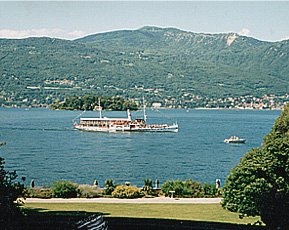
|
|
 The garden, which dates from 1820, was initially no more than a lawn following the slope of the shore down to the lakeside before the first retaining wall was built. The garden created then was in the English style, as can be seen in a photograph of 1857, and in a map dated 1867 which recently came to light.
The garden, which dates from 1820, was initially no more than a lawn following the slope of the shore down to the lakeside before the first retaining wall was built. The garden created then was in the English style, as can be seen in a photograph of 1857, and in a map dated 1867 which recently came to light.
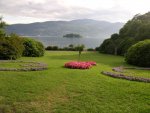
At this time permission was requested to extend the garden towards the lake and to create a new retaining wall, following which the garden was redesigned much as it can be seen today.

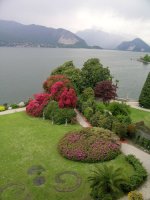
In 1899 construction of the new Villa Biffi was started but the garden with its English-style layout remained substantially unchanged, with the great lawn sloping from the house down to the lake contrasting with the shady wooded areas.


On the west side of the grounds, bordering with Villa Giulia (previously Villa Branca Melzi d’Eril), is the old lemon house with various species of citrus trees, and a double row of particularly lovely modern camellias.


In the corner towards the lake is an outstanding group of rhododendrons reaching heights of over 10 meters. There is also a splendid globe-shaped magnolia tree whose lowest branches dip into the lake when the water is high.
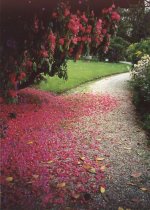
The flower beds along the lake contain plants typical of the 19th century such as golden spirea, bumalda spirea, yucca, potentilla weigelia, abelia, lobelia, hypericum, lavender, oak leafed hydrangea, edgeworthia, and many more.
The main walk descending from the villa is flanked by beds of roses which flower from April through December, and an avenue of olea fragrans, osmanthus and mimosas, alternating with 19th century statues in a lawn of convallaria japonica (a type of lily of the valley which was typical of gardens of that time.)
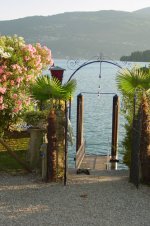
Halfway along the shore path is the wooden jetty flanked by its own private garden flowering with oleanders, broom and privet.

The heart of the garden is a splendid grove of camellias of at least 20 different varieties. Some of the finest specimens are over a hundred years old and are notable for their size and extraordinary blossoms.

Some of the azaleas which border the camellia grove also date back to the 19th century; a few modern varieties have been added in recent years.

The garden has some particularly beautiful tall trees: a splendid beech, a young gingko biloba, a number of camphor trees, an Atlantic cedar, a sequoia, a maple, and many yew, laurel and holly trees. Throughout the garden there are clumps of the exceptionally vigorous “trachycarpus fortunei” palm trees, some of them of startling height; originally imported from China, they are now a permanent resident on our lakes. An attractive feature of these palms is that their fronds ripple with the slightest breeze.

Banana trees, bamboo canes, agaves, bougainvillea and plumbago testify to the mildness of the climate and the garden’s exceptional situation on the lake shore. The old boat dock, with its mysterious shadows, full of fish swimming in the dim light, is a link between the garden and the lake.

Up until the 1950s the outbuildings included a stable block, hothouses and cold frames, a saw mill, a potting shed, and other sheds for storing oars and gardening tools.

Over the years these buildings have lost their original purpose and some have been transformed into delightful little apartments, which maintain the flavour of the original as far as possible and conserve the signs of the past and the materials that were once used – not an easy task, as time passes and with it the memory of how things used to be.
Today, old gardens are no longer regarded as exclusively private property, but as a resource for the local community. Laws have been passed granting financial aid towards the maintenance and restoration of old property. The existence of this website is, in itself, a sign of how the relationship between property owners and a public which appreciates the things of the past, is changing.
When a guest from America or Australia shows interest in the history of our house and the notes which we have carefully compiled, we feel our efforts have been repaid, and our worries and responsibilities have been worth while.
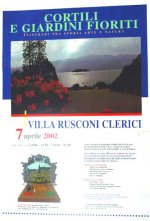
Accordingly, at different times of year we open our gates to the public. Visits are free of charge and guided by expert botanists; we also often accompany visitors on these tours, as it is a real pleasure to share this miracle of a historic garden which has survived for so long and which every year fills our lives with its colours and scents.

No description of the garden would be complete without a photo of “Villa Biffi’s Antonio”. Antonio Colombo came to work as gardener and chauffeur at the Villa in 1922 from the school of the Royal Villa in Monza; he stayed for almost 50 years. In his time the grass was cut with a scythe, there were no weed killers, there was no automatic irrigation system, seeds were not bought but had to be produced in the garden, and results depended on individual ability, experience, and sheer hard work.
Strolling with Antonio’s daughter in the garden where we played as children, memories crowded back, and there was a clear perception of the garden as a living, changing entity, responding to care and affection, an artefact as are all human creations, a mirror of the emotions of those who tend it and love it.

A final reflection on the real heart of the garden: the lake. Entering the garden, you immediately feel how closely it is bound up with the lake. Sometimes still and subdued, it can change in a moment to wild or sunny, grey, blue, green, black…
The lake is once again clean, its waters clear. The perch are more numerous than they have been for years, the tench swim in shoals around the boat dock, along with myriads of bleaks and twite shads; swans, wild ducks, grebes, kingfishers, coots, moorhens and buzzards fly once more from island to island. Civilization may yet prevail in the future!